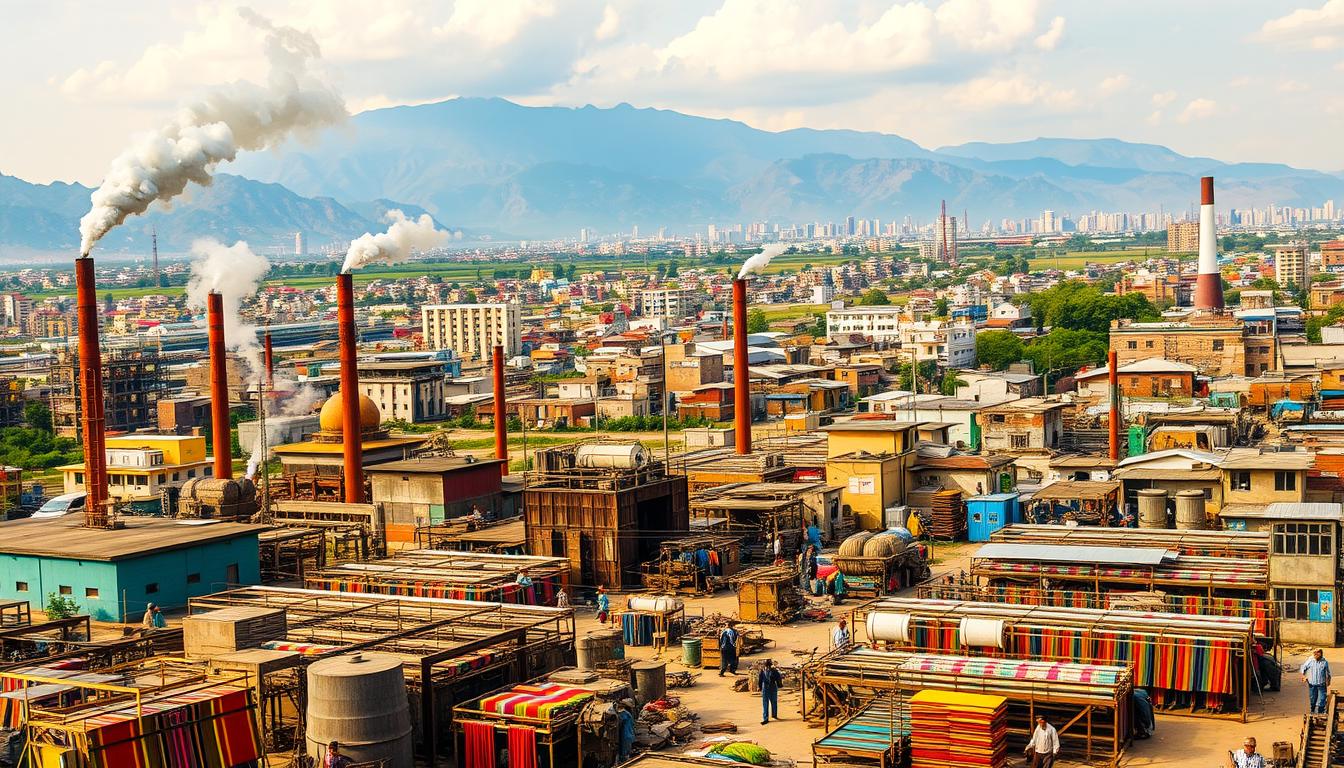Pakistan, with over 210 million people, is a key player in economic growth. It’s the thirty-third largest country and a big consumer of natural gas. With the right policies and investment, Pakistan can boost its manufacturing sector.
This article looks at Pakistan’s economy and its industrial sector. We explore how manufacturing helps the country grow and the government’s efforts to support this. We also talk about the challenges and the role of the China-Pakistan Economic Corridor (CPEC) in industrialization.
Understanding these factors is crucial. It helps us see how to speed up industrialization and unlock Pakistan’s economic potential.
Key Takeaways
- Pakistan’s large population and natural resources provide a strong foundation for industrial growth
- The manufacturing sector plays a crucial role in Pakistan’s economic development
- Government policies and initiatives aim to create a conducive environment for industrialization
- Infrastructure deficiencies, energy shortages, and skill gaps pose challenges to industrial progress
- The China-Pakistan Economic Corridor (CPEC) presents significant opportunities for industrial growth and foreign investment
Overview of Pakistan’s Economy and Industrial Sector
Pakistan is the fifth most populous country, with over 210 million people. Its economy is diverse and growing. It has a strong agricultural sector, an expanding industrial sector, and a fast-growing services sector. Despite challenges, Pakistan shows resilience and potential for growth.
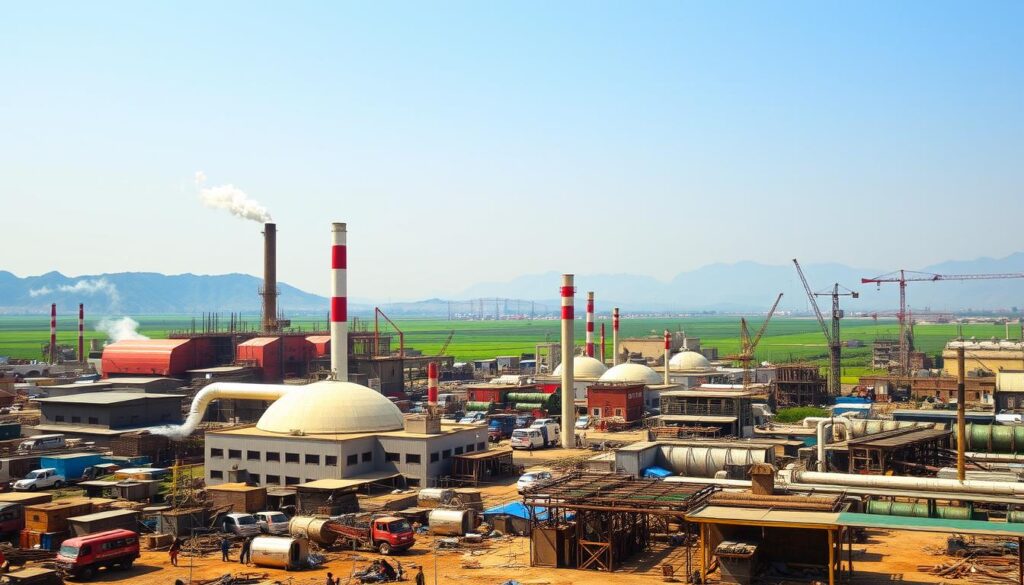
The industrial sector is key to Pakistan’s growth. It makes up a big part of the country’s GDP and job market. Industries like textiles, food processing, and automotive manufacturing are major contributors. They bring in a lot of money and create jobs for many people.
According to the Pakistan Bureau of Statistics, the industrial sector accounts for approximately 20% of the country’s GDP and employs around 24% of the total labor force.
The textile industry is a big player in Pakistan’s economy. It’s a major part of the country’s exports. Pakistan is a big cotton producer, which helps the textile industry a lot. This industry also attracts a lot of foreign investment, helping it grow and compete globally.
Other important industries in Pakistan include:
- Food processing
- Pharmaceuticals
- Construction
- Automotive manufacturing
- Chemicals
- Fertilizers
The government of Pakistan knows how important the industrial sector is. It has set up policies and initiatives to help it grow. These include offering incentives for foreign investors, creating special economic zones, and improving infrastructure.
But, Pakistan’s industrial sector still faces big challenges. It needs better infrastructure, more energy, skilled workers, and easier access to money for small businesses. Fixing these problems is key to unlocking the sector’s full potential and achieving lasting economic growth.
The Role of Manufacturing in Pakistan’s Economic Development
Pakistan’s manufacturing sector is key to its economic growth. It adds a lot to the country’s GDP and creates jobs for many people. This sector can also bring in foreign investment and help with new technologies.
Contribution to GDP and Employment
The manufacturing sector is a big part of Pakistan’s economy, making up about 13.5% of its output. This shows how important it is for creating value and boosting the economy. It also provides jobs for millions across different industries.
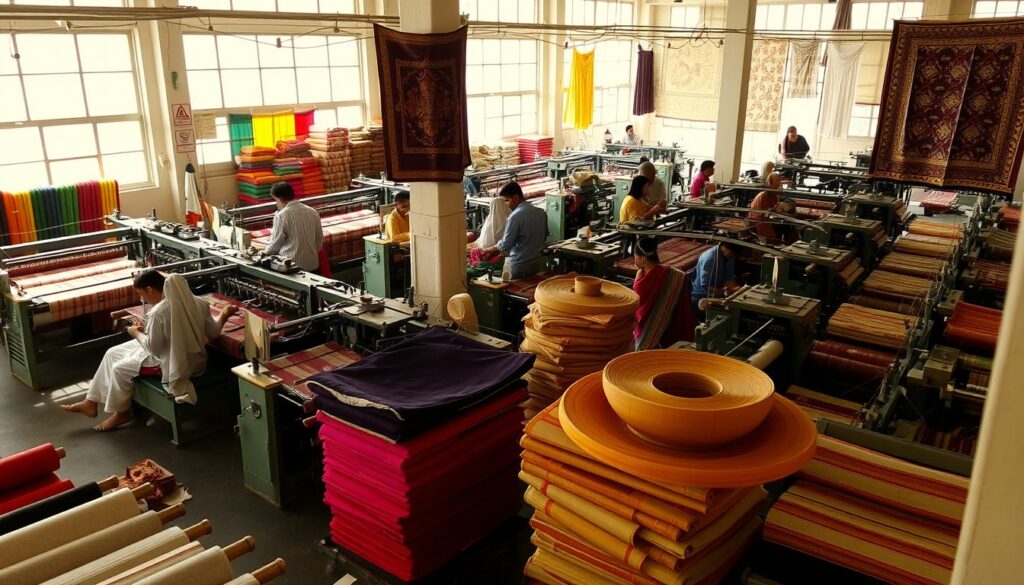
Recently, the sector has employed around 16% of Pakistan’s workforce. This makes it a major employer in the country. As it grows, it could create more jobs, especially for skilled and semi-skilled workers. This would help improve the nation’s socio-economic status.
Key Manufacturing Industries
Pakistan’s manufacturing sector includes many industries, each vital to the country’s industrial scene. Some of the main ones are:
- Textile Industry: Pakistan’s textile industry is crucial, boosting exports and creating jobs. It’s known worldwide for its quality cotton products, clothes, and home textiles.
- Food and Beverage Industry: This industry is also significant, serving both local and international markets. It produces a wide range of products, from processed foods to dairy and beverages.
- Automotive Industry: Pakistan’s automotive sector has grown a lot, with both local and foreign companies setting up here. It helps in job creation and brings in new technologies.
- Pharmaceutical Industry: Pakistan’s pharmaceutical sector has been growing, thanks to the need for more healthcare products. It focuses on making generic drugs and could grow its exports.
The table below gives an overview of these key industries and their impact on the economy:
| Industry | Contribution to GDP | Employment |
|---|---|---|
| Textile Industry | 8.5% | 40% of total manufacturing employment |
| Food and Beverage Industry | 2.2% | 15% of total manufacturing employment |
| Automotive Industry | 1.8% | 5% of total manufacturing employment |
| Pharmaceutical Industry | 1.0% | 3% of total manufacturing employment |
These industries are not just important for Pakistan’s economy. They also have the chance to attract foreign investment, lead to technological progress, and make the country more competitive globally.
Government Policies and Initiatives for Industrial Growth
The government of Pakistan is working hard to boost industrial growth. It aims to make the business environment better, attract foreign investment, and grow the economy. Key strategies include a good industrial policy, setting up special economic zones, and offering foreign investment incentives.
Industrial Policy Framework
Pakistan’s industrial policy aims to make business easier and more competitive. It simplifies rules, offers tax breaks, and supports industries. The policy also focuses on technology, research, and training to make Pakistani industries strong globally.
Special Economic Zones and Industrial Estates
Setting up special economic zones (SEZs) and industrial estates is a big part of Pakistan’s plan. These areas have modern facilities and power, helping businesses run smoothly. The government is promoting SEZs in key sectors like textiles and electronics to attract foreign investment and create jobs.
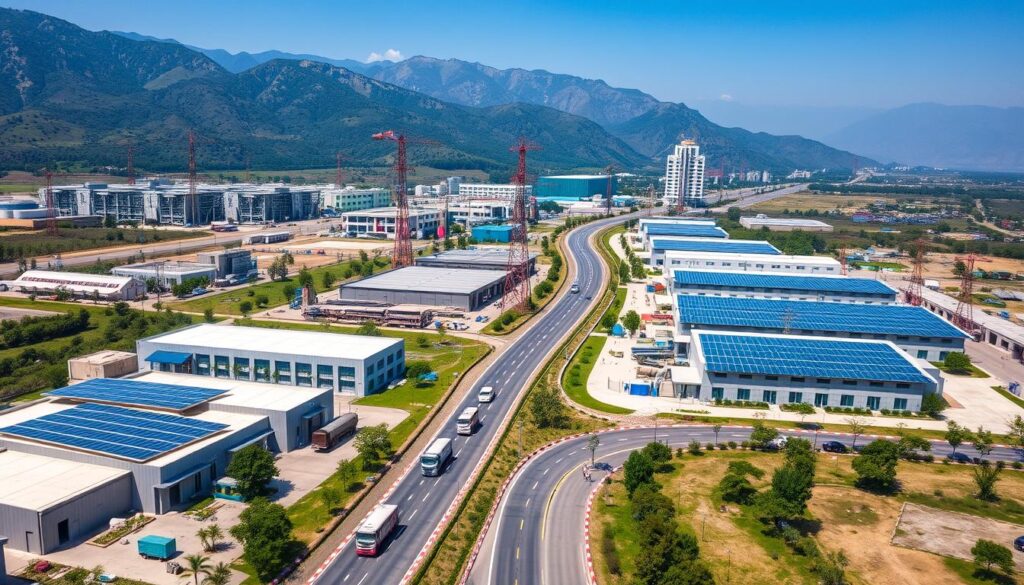
Incentives for Foreign Investment
The government offers many incentives to attract foreign investors. These include tax breaks, exemptions on imports, and the chance to take profits back home. There’s also a one-stop shop for investors and treaties with other countries to protect investments.
These policies have helped various industries grow in Pakistan. For example, the textile industry has seen big gains thanks to government support. The automotive sector has also grown, with international companies setting up in Pakistan.
| Industrial Sector | Growth Rate (2020-2021) |
|---|---|
| Textile | 5.9% |
| Automotive | 18.3% |
| Pharmaceuticals | 12.1% |
| Electronics | 7.5% |
The table shows the growth of key sectors in Pakistan, thanks to government efforts. With a focus on a business-friendly environment, better infrastructure, and foreign investment, Pakistan’s industry is set to grow even more. This will help the country’s economy a lot.
Challenges Facing Pakistan’s Industrial Sector
Pakistan’s industrial sector faces many challenges that slow its growth. These include infrastructure issues, energy shortages, and skill gaps in the workforce. Fixing these problems is key to unlocking Pakistan’s industrial potential and achieving economic growth.
Infrastructure Deficiencies
Pakistan’s industrial sector lacks good infrastructure. Industrial areas have poor roads, inefficient ports, and unreliable transport. These issues raise logistics costs, cause delays, and hurt competitiveness globally. Improving Pakistan’s infrastructure is vital for industrial growth and attracting foreign investment.
Energy Crisis and Power Shortages
The energy crisis and power shortages are big hurdles for Pakistan’s industry. Industries need steady electricity to work well. But, Pakistan’s energy sector can’t meet demand, leading to frequent power cuts.
This disrupts production and raises business costs. It forces industries to use expensive generators. Fixing the energy crisis and ensuring stable power is crucial for Pakistan’s industrial sector.
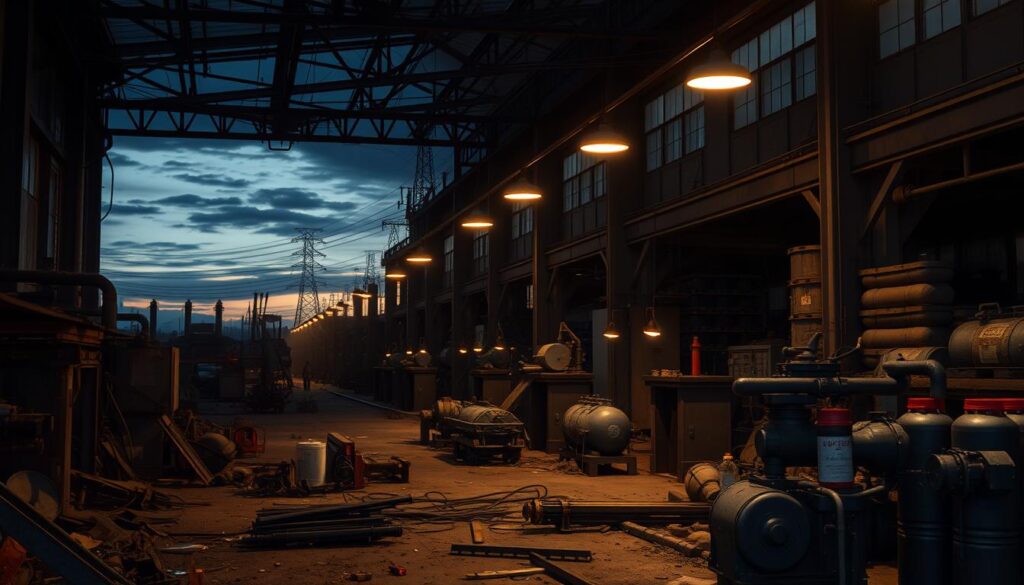
Skill Gaps in the Labor Force
Pakistan’s industry also faces skill gaps in the workforce. Many jobs need skilled workers for modern machines and quality standards. But, Pakistan’s education and training often don’t prepare workers well.
This mismatch lowers productivity and reduces innovation. To grow, Pakistan needs to bridge these skill gaps through training, industry partnerships, and investing in human capital.
| Challenge | Impact on Industrial Sector |
|---|---|
| Infrastructure Deficiencies | Increased logistics costs, delays in movement of goods, reduced competitiveness |
| Energy Crisis and Power Shortages | Disruption of production processes, increased cost of doing business, reliance on expensive backup generators |
| Skill Gaps in Labor Force | Lower productivity, reduced innovation, limited competitiveness in the global market |
Fixing these challenges needs a team effort from the government, industry, and international partners. By improving infrastructure, solving the energy crisis, and closing skill gaps, Pakistan can reach its industrial potential. This will create a good environment for sustainable economic growth.
Opportunities for Industrialization in Pakistan
Pakistan is at the crossroads of South Asia, Central Asia, and the Middle East. This strategic location offers unique industrialization chances. It’s close to major markets and trade routes, making it a potential hub for trade and investment.
With over 220 million people, Pakistan has a large and growing domestic market. This market is perfect for industrial products and services.
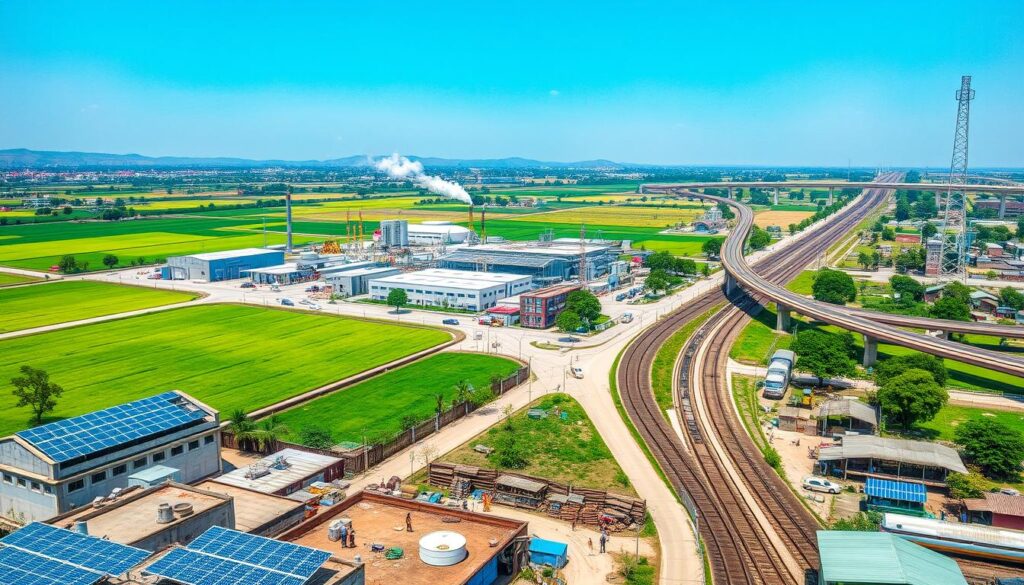
Pakistan’s export potential is a key area for industrial growth. It has a variety of industries like textiles, leather goods, and agricultural products. These have high demand in international markets.
By investing in modern technology and improving quality, Pakistan can boost its exports. This will open up new markets for the country.
Developing value-added industries is another opportunity. Pakistan’s strong agricultural sector provides raw materials for industries like food processing and textiles. Focusing on value addition can create higher-value exports and more jobs.
The energy sector also offers big chances for growth. Pakistan needs more electricity and wants to reduce fuel imports. Investing in renewable energy like solar and wind can support energy-intensive industries and attract foreign investment.
“Pakistan’s strategic location, large domestic market, and diverse industrial base offer immense potential for industrialization and economic growth. By addressing infrastructure gaps, improving the business environment, and fostering innovation, Pakistan can unlock its true potential and become a regional manufacturing hub.” – Economic Analyst, XYZ Consulting
To make the most of these chances, Pakistan must tackle several challenges. These include:
- Improving infrastructure, especially in transportation, energy, and logistics
- Enhancing the ease of doing business by streamlining regulations and reducing red tape
- Investing in human capital development to bridge skill gaps and promote innovation
- Attracting foreign direct investment by creating a business-friendly environment and offering incentives
| Sector | Industrialization Opportunities |
|---|---|
| Textiles | Modernization of machinery, product diversification, and value addition |
| Agriculture | Food processing, packaging, and export of high-value agricultural products |
| Energy | Investment in renewable energy projects and development of energy infrastructure |
| Information Technology | Development of software and IT services industry, outsourcing opportunities |
Pakistan can create a great environment for industrial growth by using its location and market. With the right policies, infrastructure, and investment in people, Pakistan can become a major manufacturing hub. This will drive sustainable economic growth.
The Impact of China-Pakistan Economic Corridor (CPEC) on Industrialization
The China-Pakistan Economic Corridor (CPEC) is changing Pakistan’s industrial scene for the better. It offers big chances for growth and development. This huge project aims to strengthen ties between China and Pakistan, fix infrastructure gaps, and boost industrial power.
Infrastructure Development under CPEC
CPEC focuses a lot on building better infrastructure. This is key for industrial growth. It includes making highways, railways, ports, and energy projects. These help businesses grow by improving connectivity and cutting down costs.
Special economic zones (SEZs) are a big part of CPEC’s plan. These zones offer a great place for businesses with modern facilities and easy rules. They are centers for innovation, technology sharing, and job making.
Chinese Investment in Pakistan’s Industrial Sector
CPEC has brought a lot of Chinese money into Pakistan’s industry. China, a big player in manufacturing, brings money, skills, and new tech. Chinese companies are starting factories in many areas, like textiles and electronics.
This Chinese money will help Pakistan’s industry grow, create jobs, and increase exports. Pakistani companies can join global markets with Chinese help. Also, Chinese tech and knowledge will help Pakistan’s industry get better and more productive.
| Sector | Chinese Investment (USD Billion) | Expected Job Creation |
|---|---|---|
| Energy | 33.8 | 30,000 |
| Infrastructure | 11.8 | 80,000 |
| Gwadar Port | 0.8 | 40,000 |
The table shows big Chinese investment in sectors like energy and infrastructure. These investments will create thousands of jobs. They will help Pakistan grow socially and economically.
As CPEC moves forward, it will change Pakistan’s industry a lot. It will fix infrastructure, bring in foreign money, and help technology grow. This could make Pakistan a strong player in the world market.
Strategies for Promoting Technology Transfer and Innovation
Pakistan’s industrial sector can greatly benefit from effective strategies. These strategies should promote technology transfer and foster innovation. By sharing knowledge and expertise between research institutions, universities, and industries, Pakistan can advance technologically and grow economically.
One key approach is through robust industry-academia collaboration. Strong partnerships between universities and businesses can lead to the development of cutting-edge technologies. These collaborations can include joint research projects, internships, and mentorship programs. This allows students and researchers to gain practical experience while industries benefit from fresh perspectives and ideas.
Another essential strategy is to invest in research and development (R&D) activities. By allocating resources to R&D, Pakistan can encourage the creation of new technologies. The government can provide financial incentives, such as grants and tax breaks, to companies engaging in R&D activities. Additionally, establishing dedicated research centers and technology parks can create hubs for innovation and facilitate the commercialization of research findings.
“Innovation distinguishes between a leader and a follower.” – Steve Jobs
To further promote technology transfer and innovation, Pakistan can consider the following measures:
- Developing a comprehensive intellectual property rights (IPR) framework to protect the interests of innovators and encourage the commercialization of new technologies.
- Encouraging the adoption of advanced manufacturing techniques, such as automation and digitalization, to improve productivity and competitiveness.
- Promoting international collaborations and partnerships to access global knowledge networks and facilitate the transfer of best practices.
- Investing in human capital development to build a skilled workforce capable of driving innovation and absorbing new technologies.
By implementing these strategies, Pakistan can create an ecosystem that nurtures innovation. This ecosystem will facilitate technology transfer and drive the growth of its industrial sector. Embracing a culture of continuous improvement and technological advancement will be crucial in positioning Pakistan as a competitive player in the global market.
The Importance of Small and Medium Enterprises (SMEs) in Industrial Growth
Small and Medium Enterprises (SMEs) are key to Pakistan’s industrial growth and economic development. They are crucial for the country’s economy, employing fewer than 250 people and having a certain annual turnover. SMEs create jobs, innovate, and produce goods and services for both local and international markets.
In Pakistan, SMEs make up over 90% of all businesses and employ about 80% of non-agricultural workers. They work in various sectors like manufacturing, services, and agriculture. SMEs are vital for inclusive economic growth and reducing poverty. They encourage entrepreneurship and self-employment, making the economy more resilient and diverse.
Challenges Faced by SMEs in Pakistan
Despite their importance, SMEs in Pakistan face many challenges. These include:
- Limited access to finance and credit
- Inadequate infrastructure and energy supply
- Lack of skilled labor and managerial expertise
- Burdensome regulations and bureaucratic procedures
- Insufficient market linkages and information
These challenges make it hard for SMEs to grow, adopt new technologies, and compete in markets. It’s essential to address these issues to unlock SMEs’ full potential and promote sustainable growth in Pakistan.
Government Support for SME Development
The government of Pakistan recognizes SMEs’ importance and has launched various initiatives to support them. Some key efforts include:
- The SME Policy 2007, a comprehensive framework for SME growth and competitiveness
- The establishment of the Small and Medium Enterprises Development Authority (SMEDA) for technical and financial help
- The Prime Minister’s Youth Business Loan Scheme, offering subsidized loans to young entrepreneurs
- Creating industrial clusters and special economic zones for SMEs’ infrastructure and incentives
However, more needs to be done to support SMEs. This includes simplifying regulations, improving finance access, investing in skills, and promoting innovation and technology. By addressing SME challenges and providing targeted support, Pakistan can unlock their potential for industrial growth and a more prosperous economy.
| SME Sector | Contribution to GDP | Employment Share |
|---|---|---|
| Manufacturing | 30% | 35% |
| Services | 50% | 45% |
| Agriculture | 20% | 20% |
The Way Forward: Recommendations for Accelerating Industrialization in Pakistan
To speed up industrial growth in Pakistan, we need a detailed plan. This plan should include policy changes, better infrastructure, and more skilled workers. The government should make it easier for businesses to start and grow. This means cutting down on red tape and making decisions clear.
Investing in things like energy and roads is also key. It will help businesses grow and attract money from outside the country.
Improving human skills is vital for Pakistan’s growth. We should focus on training and partnerships between schools and companies. This will help fill skill gaps and encourage new ideas.
Supporting research and bringing in new technologies is also important. It will make Pakistan’s industries more competitive.
Finally, using green practices is crucial for long-term success. Pakistan should use eco-friendly tech and work towards a circular economy. This will make it a leader in sustainable industry.
Working together, the government, private sector, and international partners can help Pakistan reach its full potential. This will lead to a strong, industrialized future.
- Overview of Pakistan's Economy and Industrial Sector
- The Role of Manufacturing in Pakistan's Economic Development
- Government Policies and Initiatives for Industrial Growth
- Challenges Facing Pakistan's Industrial Sector
- Opportunities for Industrialization in Pakistan
- The Impact of China-Pakistan Economic Corridor (CPEC) on Industrialization
- Strategies for Promoting Technology Transfer and Innovation
- The Importance of Small and Medium Enterprises (SMEs) in Industrial Growth
- The Way Forward: Recommendations for Accelerating Industrialization in Pakistan
